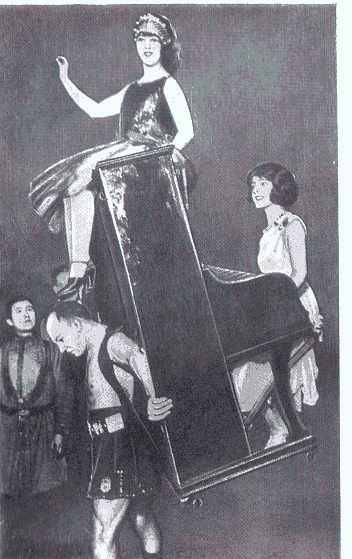Alexander Zass was a strongman in the circus, traveling around Russia for many years back around the beginning of the twentieth century. He was born in Vilnius, Lithuania and lived from 1888 to 1962.
Alexander Zass was a strongman in the circus, traveling around Russia for many years back around the beginning of the twentieth century. He was born in Vilnius, Lithuania and lived from 1888 to 1962.
While serving in the Russian army during the First World War, he was captured by opposing forces and escaped from prisoner of war camps not once – but a total of four times. Some of these were easy escapes, but not the last one (his captors finally caught on that he wanted to be free). Here he used his strength to break his shackles and bend the iron bars of his window to climb out of jail. As you can see, his amazing strength proved to be quite useful.
Zass was not a weight lifter but performed feats such as bending bars, breaking chains, massive support and carrying lifts, and even several teeth lifts. In this video, the only known footage of the man, you can see him execute several of these feats:
During his youth, as weightlifting equipment was not easy to come by, Zass made do with rocks, trees, and other items that were easily found. He made his first barbells by chipping holes into stones and inserting an iron bar between them. Here’s some more detail that Zass relayed on how he focused his efforts on hand strength, using what was available:
I commenced now to think a lot about developing great strength in my fingers. Many things I tried, all helping, some of which I will tell you. I bent thick, green twigs with my hands, these being better than dry wood, which would not bend much before it would snap. I practised this a good deal until my hands became so strong that I could bend even small boughs of trees till they broke. Also I tried lifting stones off the ground with my thumb and fingers, carrying them in my grip for some distance.
According to Zass, if you want to become super-humanly strong you must concentrate on the hands and wrists. These are the weak link in so many people’s training, that it is what often makes the difference between a strongman and a normal person. And as described by another famous strongman William Pullum, “The keystone of the Samson system is the development of the strength of the tendons.”
There is not a lot of muscle mass in the hands. Even the forearms don’t have much in comparison to other areas of the body. Much more of the strength to be gained in the grip is by developing the strength of the tendons and ligaments. In support feats, even bone strength comes into play.

But progressive work is where it’s at, and apparently always has been. In his writing, Zass shared what he believed to be one of the most important secrets of gaining unbelievable strength.
“The secret of all improvement in feats like this is gradual progress from one stage to another, the severity of the test only being increased by degrees that are hardly noticeable.” I’ve seen it all too often (and also done it myself). Too many people seek improvement too quickly and actually stunt their gains. Small, gradual progression may seem to take longer but gives better results in the long run.
Zass was also a big proponent of isometric exercises, where you resist against an immovable object. For training these he liked using handles connected by a thick chain. Here he explains the benefits of doing isometrics:
The great secret of developing strength is to do so in a way which will store up energy instead of dissipating it, and build up the stamina as well; and the only method I know which really does this is exercise against very strong resistance.
In the book The Mystery of the Iron Samson, some of Zass’s isometric training methods are discussed:
Modern research has shown that the duration of isometric exercise should depend on the degree of muscular tension. If 60-70% of maximum strength is applied, then the muscular effort should last 6-10 seconds. If 80-90% of maximum strength is applied, then the muscular effort should last 4-6 seconds, and at 100%, only 2-3 seconds effort should be exerted.
A great thing about isometrics is that they allow you to train at certain angles and positions that can’t be replicated by lifting weights or other exercises. Besides being a strongman, Zass was a phenomenal wrestler. This makes sense, as wrestling, if you stop to look at it, is a match of many isometric and isotonic exercises against your opponent, at many weird angles. Zass was, in fact, one of a great many strongmen with a wrestling background.
To sum up, Zass built his strength using what he had available. Without using modern dumbbells and barbells, he became one of the strongest men in history. He learned from others but also ended up developing his own system using a mixture of dynamic and isometric exercises, content to make small gains in strength over time, which led to amazing feats of strength.
References:
1. The Mystery of the Iron Samson, Yuri Shapshnikoff and A. Drapkin (Strongman Books, 2012, South Carolina) pg. 91
2. The Amazing Samson, Alexander Zass (Strongman Books, 2011, South Carolina) pg. 96, 180, 209, 233






